Books
Books
published in 2023

Viscose 05: Retail
Viscose is a journal for fashion criticism. The fifth issue of Viscose explores fashion’s multifaceted retail spaces and cultures. With the evolution of shopping in the 20th and 21st centuries as its focus, the issue looks at the shop as a central nexus where communities and identities are continuously produced and re-imagined through commerce. With a special attention to the role of fashion retail within urban spatial politics, we seek out histories of projects—often developed with or by artists—that have embraced the shop as a medium of both possibility and contestation.
With contributions by:
Dennis Brzek, Anastasia Howe Bukowski, Michael Bullock, Felix Burrichter, Canal Street Research Association, Noah Dillon, Harun Farocki, Anna Franceschini, Ignacio Gatica, Christian Hincapié, Juje Hsiung, Jessica Kwok, Rhonda Lieberman, Matthew Linde, Marge Monko, Cheuk Ng, Luis Ortega, Camila Palomino, Andreas Petrossiants, Leah Pires, International Library For Fashion Research, Vésma Kontere Mcquillan (International Library For Fashion Research), Rose Salane, Alice Sarmiento, Museum Of Modern Shopping, Jeppe Ugelvig, Sean Vegezzi, Post Vsop, Evie Ward, Leah Weirer
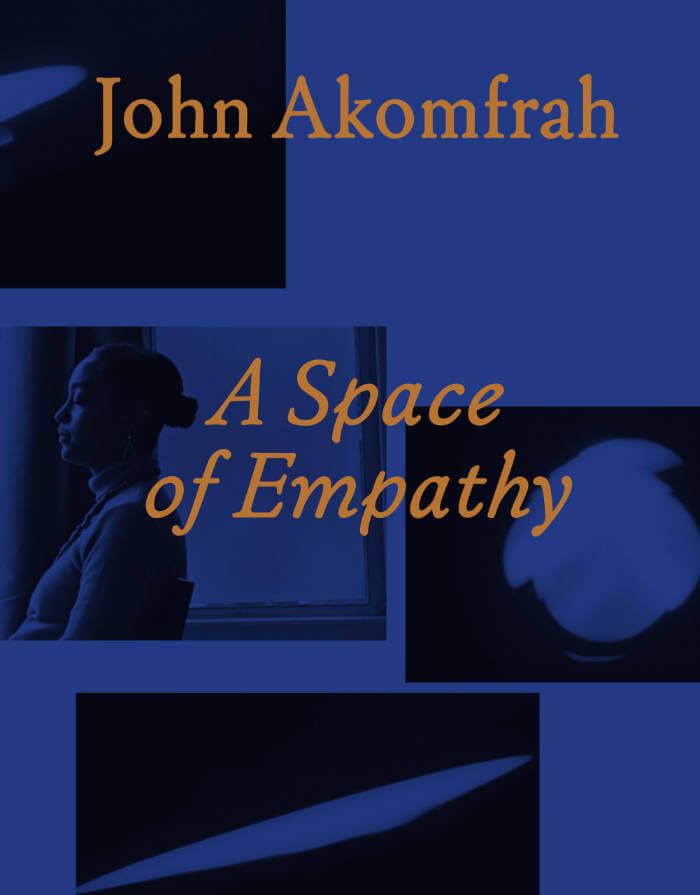
A Space of Empathy
An overview of John Akomfrah's work, with contributions by Julia Grosse and Nelly Y. Pinkrah, an interview with the artist, along with a foreword by Sebastian Baden.
John Akomfrah creates thoughtful video works of haunting audiovisual intensity. He tells of the radical changes and crises of the present and past on characteristic large-format screens. From November 9, 2023 to January 28, 2024, the Schirn Kunsthalle Frankfurt is presenting for the first time a comprehensive overview of the artist's work in Germany, featuring a selection of three major multichannel installations from recent years: The Unfinished Conversation (2012), Vertigo Sea (2015), and Akomfrah's new work, Becoming Wind (2023). A co-founder of the influential London-based Black Audio Film Collective (established in 1982), Akomfrah's work interweaves newly shot film sequences with archival material to create multilayered, at times associative collages, frequently in the form of simultaneous narrative structures.
Akomfrah's immersive installations critically examine colonial pasts, global migration, and the climate crisis. He addresses one-dimensional historical representations by allowing multiple perspectives to emerge in the narrative, disrupting the notion of linearity and the illusion of a one and only truth.
Published on the occasion of the eponymous exhibition at Schirn Kunsthalle Frankfurt in 2023-2024.
John Akomfrah (born 1957) is a British artist, writer, film director, screenwriter, theorist and curator. His works are characterised by their investigations into memory, post-colonialism, cultural identity, temporality and aesthetics and often explores the experiences of migrant diasporas globally. Akomfrah was a founding member of the influential Black Audio Film Collective, which started in London in 1982 alongside the artists David Lawson and Lina Gopaul, who he still collaborates with today.
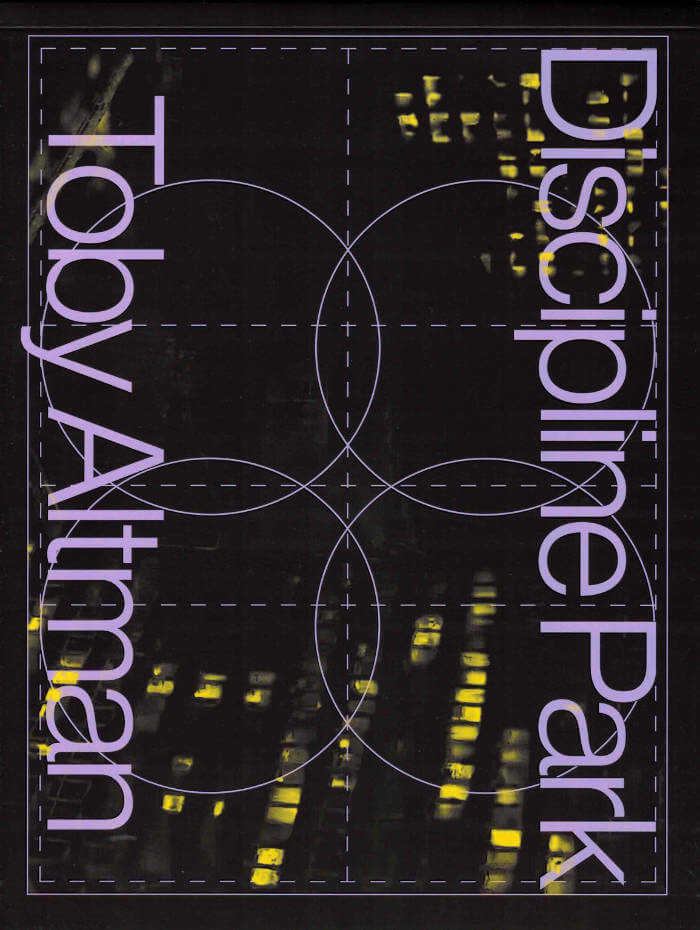
Discipline Park
Toby Altman’s Discipline Park documents the demolition of Prentice Women's Hospital in Chicago, a landmark of architectural brutalism designed by Bertrand Goldberg in the 1970s. Altman was born in the building, and years later, was employed by Northwestern University when they tore it down. His personal proximity to the site leads to a wider critical evaluation of the cruelty of a neoliberalism that asks us to draw sustenance from the very institutions that poison and erase our bodies, habitats, and histories. But, as it indicts the present and its claustrophobic, ruinous politics, Discipline Park also recovers or reinvents utopian vistas through an extended engagement with Goldberg's architectural practices.
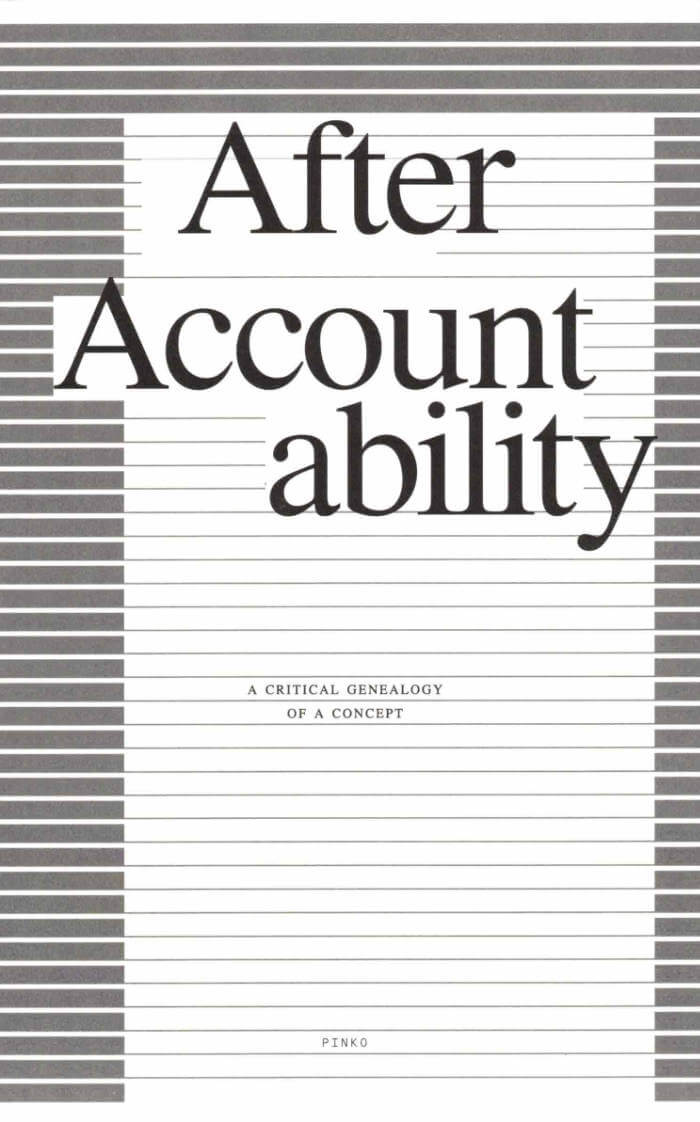
After Accountability
A concept just short of a program, accountability has been taken up as a core principle within leftist organizing and activity over the past quarter century. While it invokes a particular vocabulary and set of procedures, it has also come to describe a more expansive, if often vague, approach to addressing harm within movement work. The term’s sudden, widespread adoption as abolitionist concepts began to circulate broadly in recent years cast light on certain shifts in its meaning, renewing the urgency of understanding its relation to militant history and practice.
After Accountability is an oral history and critical genealogy of this decisive movement concept that gathers interviews with eight transformative justice practitioners, socialist labor organizers, incarcerated abolitionists, and activists on the left conducted by members of the Pinko collective. An investigation into the theoretical foundations and current practice of accountability, this volume explores the term’s potential and limits, discovering in it traces of the past half-century’s struggles over the absence of community and the form revolutionary activity should take.
Pinko is a collective for thinking gay communism together. Pinko publishes a biannual print issue and periodic zines, and hosts irregular essays, translations, and archival material on their website.
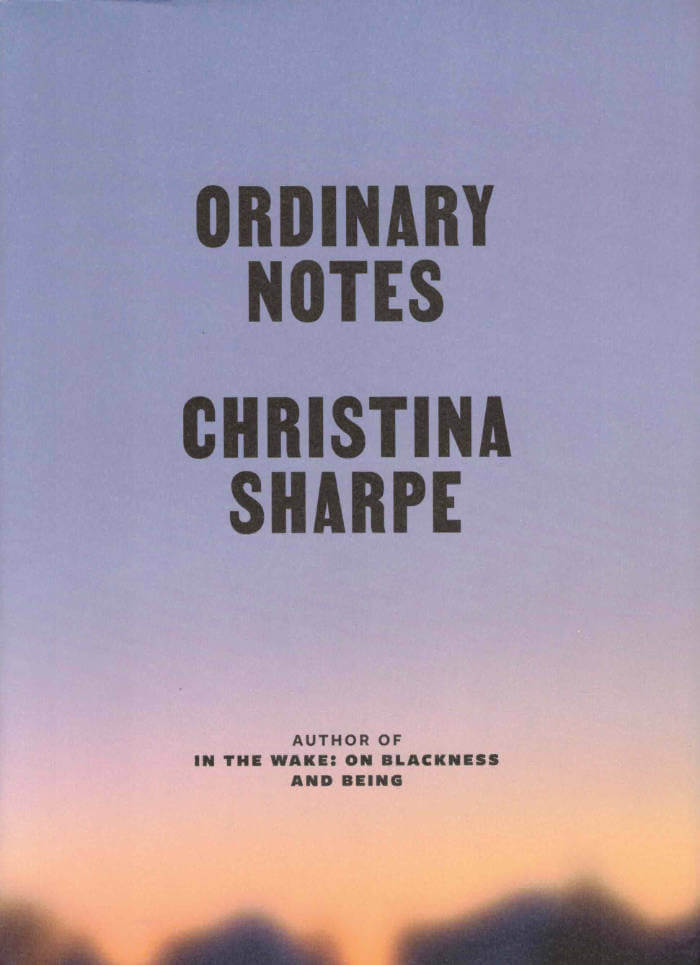
Ordinary Notes
A singular achievement, Ordinary Notes explores profound questions about loss and the shapes of Black life that emerge in the wake. In a series of 248 notes that gather meaning as we read them, Christina Sharpe skillfully weaves artifacts from the past—public ones alongside others that are poignantly personal—with present realities and possible futures, intricately constructing an immersive portrait of everyday Black existence. The themes and tones that echo through these pages—sometimes about language, beauty, memory; sometimes about history, art, photography, and literature—always attend, with exquisite care, to the ordinary-extraordinary dimensions of Black life.
At the heart of Ordinary Notes is the indelible presence of the author’s mother, Ida Wright Sharpe. “I learned to see in my mother’s house,” writes Sharpe. “I learned how not to see in my mother’s house . . . My mother gifted me a love of beauty, a love of words.” Using these gifts and other ways of seeing, Sharpe steadily summons a chorus of voices and experiences to the page. She practices an aesthetic of "beauty as a method,” collects entries from a community of thinkers toward a “Dictionary of Untranslatable Blackness,” and rigorously examines sites of memory and memorial. And in the process, she forges a brilliant new literary form, as multivalent as the ways of Black being it traces.
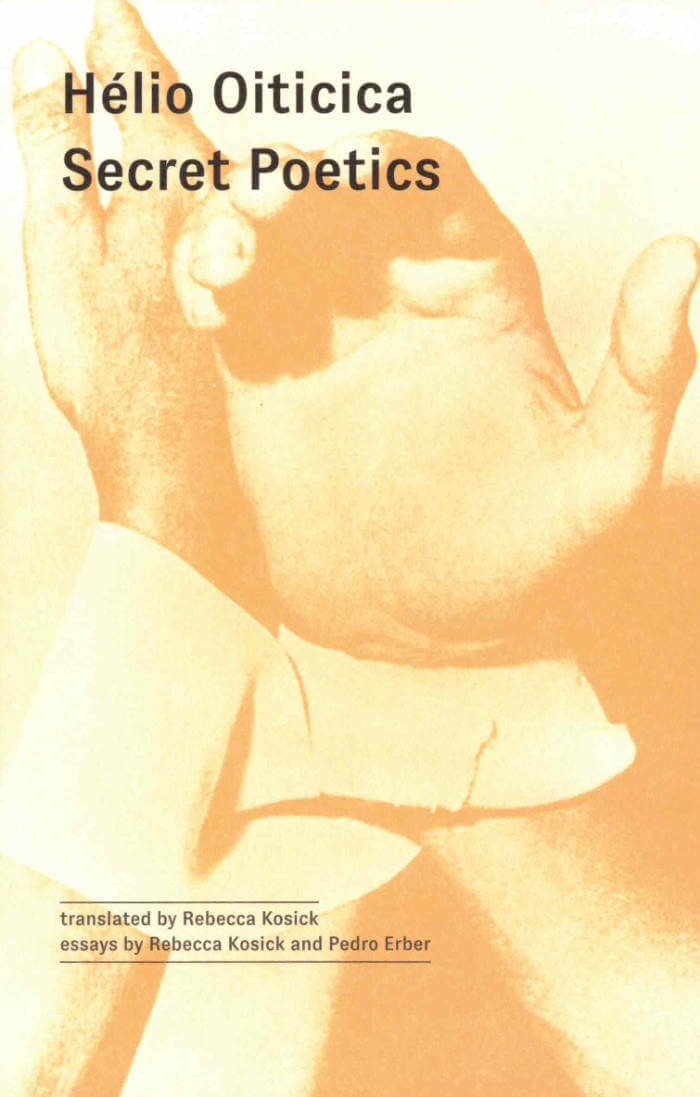
Secret Poetics
Hélio Oiticica (1937-80) is widely considered one of Brazil's most significant artists, and his influence is felt across a range of disciplines including painting, film, installation and participatory art. He is well known as a key founder of the interdisciplinary movement known as Neoconcretismo, launched in Rio de Janeiro in 1959 with the collaboration of artists and writers including Lygia Clark, Lygia Pape and Ferreira Gullar.
Between 1964 and 1966, moving out of his Neoconcretist period, Oiticica wrote a series of lyrical poems entitled Poâetica Secreta (Secret Poetics), and he reflected in a private notebook on their significance for his wider practice as an artist. Despite Oiticica's global fame, his "secret" poems are almost unknown and have never been published as a collection.
This bilingual edition, with accompanying essays by translator Rebecca Kosick and critic Pedro Erber, uncovers the significance of poetry for Oititica's art and shows its importance to his thinking on participation, sensation and memory

F.R. David - "Erratum"
Following an open call, this is—the very last issue—a collectively-compiled "Erratum", or addendum [if you will] to the twenty-three issues from 2007 until now.
Edited with Paul Abbott, After 8, Alma Sarif, Phil Baber, Daniel Blumberg, Thomas Boutoux, Kristien Van den Brande, Chloe Chignell, Martina Copley, Anthony Elms, Chris Evans, Carolina Festa, Kasper Feyrer, Richard Finlay Fletcher, Ben Green, Mariëtte Groot, Krist Gruijthuijsen, Léa Guillon, Sarah Handley, Gloria Hasnay, Loes Jacobs, Michel Khleifi, Willis Kingery, gerlach en koop, James Goggin, Keira Greene, Léa Guillon, Jacob Lindgren, Kobe Matthijs, Martino Morandi, Zen Nguyen, Alice Notley, Robert M. Ochshorn, Oscar the dog, Willem Oorebeek, David Reinfurt, Scott Rogers, Andrés de Santiago Areizaga, Rosa Sarholz, Clara Schulmann, Andrea di Serego Alighieri, Sabrina Tarasoff, Kristy Trinier, Seymour Wright and Unknown.
F.R.DAVID is a typographical journal, dealing with the organization of reading and writing in contemporary art practices. It was published by de Appel in Amsterdam (2007–2016) and is currently co-published by KW with uh books.

Blank Forms #09 – Sound Signatures
The penultimate Blank Forms anthology presents new, in-depth interviews with musicians Theo Parrish, Amelia Cuni, Akio Suzuki, and more.
At the centerpiece of Blank Forms 09: Sound Signatures is a career-spanning, twenty-hour conversation conducted over four days between producer, remixer, and Detroit house music legend Theo Parrish and veteran music journalist Mike Rubin. They go deep on Parrish's childhood in Chicago's South Side, sculptural training, and collaborations with Moodymann, Rick Wilhite, and Omar S, and explore how the social movements of 2020 have reshaped his practice and dance music at large. This volume also includes an heavily-illustrated discussion between Dhrupad singer Amelia Cuni and sound artist/tuning theorist Marcus Pal, covering Cuni's years studying voice and dance in India, her interpretations of John Cage's ragas, and collaborations with the likes of La Monte Young and Catherine Christer Hennix—accompanied by deeply researched essays from Cuni on Hindustani classical music and avant-garde performance. Finally, the collection features reminiscences from composer and performer Akio Suzuki and musician Aki Onda on Japanese Fluxus pioneer and Taj Mahal Travellers founder Takehisa Kosugi (1938–2018), with newly translated art criticism from Kosugi.
Blank Forms' journal brings together a combination of never-before published, lost, and new materials that supplement Blank Forms' live programs. It is envisioned as a platform for critical reflection and extended dialogue between scholars, artists, and other figures working within the world of experimental music and art.
Texts by Takehisa Kosugi and Amelia Cuni; interviews with Amelia Cuni by Marcus Pal, Akio Suzuki by Aki Onda, Theo Parrish by Mike Rubin.

Spectres IV: A Thousand Voices
Bartolomé Sanson, François J. Bonnet
The fourth issue of the annual publication dedicated to sound and music experimentation, co-published by Shelter Press and Ina GRM – Groupe de Recherches Musicales, around the topic of voice.
The voice is everywhere, infiltrating everything, making civilisation, marking out territories with infinite borders, spreading from the farthest reaches to the most intimate spaces. It can be neither reduced nor summarised. And accordingly, when taken as a theme, the voice is inexhaustible, even when seen in the light of its very particular relation with the sonic or the musical, as is the case in most of the texts collected in this volume. There is no point therefore in trying to circumscribe or amalgamate the multiple avatars of the voice. We must rather try to apprehend what the voice can do, to envisage its landscape, its potential effects.
Spectres is an annual publication dedicated to sound and music experimentation, co-published by Shelter Press and Ina GRM – Groupe de Recherches Musicales.
Edited by François J. Bonnet and Bartolomé Sanson.
Contributions by Joan La Barbara, Sarah Hennies, Peter Szendy, Youmna Saba, Lee Gamble, Ghédalia Tazartès, David Grubbs, Stine Janvin, Pierre Schaeffer, Akira Sakata, Haela Ravenna Hunt-Hendrix, Yannick Guédon, François J. Bonnet, John Giorno.

Robida 9
Robida is a situated, multilingual cultural magazine published by Robida collective. Each issue explores a topic connected and generated by Topolò/Topolove, the village on the border between Italy and Slovenia where the collective is based.
The chosen topic is thrown into the world and interpreted by people who have never been to Topolò. What people send back after the open call is not only a contribution to the exploration of a defined theme but also a new interpretational tool to explore the collective’s relation to Topolò.
The ninth issue of Robida magazine digs into soil, dirt, mud, earth, ground and compost, which are interpreted through six categories, each proposed by one editor of the magazine: symbolic, feminist, theoretical, dwelling, contaminated and tactile soils.
〰️
CONTRIBUTORS
Adriana Gallo, Alecio Ferrari, Aljaž Škrlep, Anaïs Tondeur, Angela Serino, Anna Lina Litz, antonisotzu, Antônio Frederico Lasalvia, Beatrice Zerbato, Benedetta Ciappini, Chiara Alexandra Young, Chiara Caredda, Diego García, Donatella Livigni, Dora Ciccone, Eduardo Makoszay Mayén, Eleanor White, Elena Ferrari, Elena Rucli, Emily Priest, Emmanuel Álvarez Sánchez , FAHR 021.3, Federico Bardelli, Federico Broggini, Francesca Lucchitta, Georgina Pantazopoulou, Germain Meulemans, Gijs de Boer, Giorgia Maurovich, Giulia Pompilj, Greta Biondi, Hannah Segerkrantz, How Melnyczuk, Jack Bardwell, Janja Šušnjar, jean ni, Laura Savina, Luca Scandurra, Lucia Fontanelli, Marianna Maruyama, Margherita Issori, masharu, Michael Marder, Naomi Oke, Ola Korbańska, Petra Filagrana, René Nissen, Rūta Žemčugovaitė, Silvia Marchese, Sofia Salvatori, Sasha van Aalst, Stefan Breit, Steffie de Gaetano, Stephanie Newcomb, Tina Alise Drupa, Toni Wagner, Tymon Hogenelst, Vida Rucli, Vittoria Rubini, Yiannis I. Andronikidis, Yvonne Billimore, Zuzanna Skurka.

Drum Listens to Heart
Accompanying the 2022 exhibition at Wattis Institute for Contemporary Arts in San Francisco, Drum Listens to Heart reflects on the many ways that percussion exists beyond the framework of music and imagines "the percussive" as an aesthetic, expressive and political form more broadly. The publication includes a new essay by the curator, images of the works in the exhibition by the 25 artists and artist collectives, and short texts by 10 scholars, writers, artists and curators who respond to a single word to create a "glossary" of terms associated with percussion.
Artists include: Francis Alÿs, Luke Anguhadluq, Marcos Ávila Forero, Raven Chacon, Em'kal Eyongakpa, Theaster Gates, Milford Graves, David Hammons, Consuelo Tupper Hernández, Susan Howe & David Grubbs, NIC Kay, Barry Le Va, Rose Lowder, Lee Lozano, Guadalupe Maravilla, Harold Mendez, Rie Nakajima, the Otolith Group, Lucy Raven, Davina Semo, Michael E. Smith, Haegue Yang and David Zink Yi. Live performances by Elysia Crampton Chuquimia, Moor Mother, Nkisi, Nomon, Karen Stackpole, Marshall Trammell and William Winant.

Islands After Tourism
Tourism does more than transforming spaces and forcing emotions: its geographies also conceal a persisting power that captures the imagination. In their operational sturdiness, tourismscapes appear intractable and inert, making their alternative renderings almost unthinkable. It feels uncanny to picture islands and their coasts freed from programs of leisure. But in recent years, the exhaustion of people and landscapes has brought forth a renewed imperative to think outside this ubiquitous extractive industry. Through essays, pieces of fiction, and visual references, this book discusses both the difficulty and the necessity of disrupting the monocultural imaginations of tourism. To escape the devouring vortex of its sticky nature and messianic promises, the cultural and political work necessary is not only this of negation and resistance, but also that of bold re-conceptualizations and re-imaginings.

In the Mirror of Care Work
Ar Utke Acs, Inga Gerner Nielsen
In the Mirror of Care Work was initiated by Inga Gerner Nielsen and Ar Utke Acs, two Danish artists whose work spans immersive performance, dance, choreography, curation and sociology. At two events in 2021 and 2022 that hosted dialogues between nurses and interactive performers, Nielsen and Acs began collecting stories and responses to conversational exercises, the latter of which revolved around questions such as – What can performance artists learn from nurses? How does the interactive performer's engagement with the audience correlate with the nurse's work with a patient? What skills, techniques, and strategies might these two fields share?
The exchange of knowledge from these two gatherings formed the basis of an ongoing dialogic project, as well as the content of this publication, which has been supplemented with seven essays by nurses, educators, performance theorists and performers. The book includes a series of drawings commissioned from artist Marit Benthe Norheim, graphics by TABLOID Press co-director Nat Marcus, and photographs of a performance installation staged by Nielsen and Acs in the Department of Nursing Education at University College of Northern Denmark – Hjørring.
Edited by Inga Gerner Nielsen and Ar Utke Acs, editorial assistance from Nat Marcus.
With essays by Elvira Crois, Majula Drammeh, Vienne Chan, Helle Kronborg Krogsgaard, Tyra Wigg, Rikke Steen Mapstone and Ar Utke Acs.

Basic Mechanics
Isabelle Weber, Maud Gyssels and 1 more
Basic Mechanics is a hold-loose collection of words as findlings and carriers, that hold or lose meaning. Consequently, a description of this work will never simply come out of one’s mouth. The narrative will seem tied together with loose threads. As Ursula K. Le Guin writes in The Carrier Bag Theory of Fiction, we know the story of the hero with the spear and the violence and the teleological progression. But isn’t the story that can be told by all, one of carrying and being carried? Isn’t language a wrapping for all those contradictory and wondrous thoughts and feelings? And can they be captured on paper, for a while, and set free again to counterbalance the killer story?
Confessing secrets and desires to each other became a method of sharing. Accompanied by giggles, we somatically connected the stories we carry, which we (dare to) place with another, which move from the inside out. This publication spills, soaks, opens and closes to confessions, poems and drawings in looping motifs. A shell swimming in a sea of words.

The Posthumanist #2 Rhythms / Rhythmen
The Posthumanist is a bi-annual English and German magazine featuring art, design, technology and writing. Each issue presents one theme from various more-than-human perspectives, inviting readers to imagine what living together on planet earth is and could be.
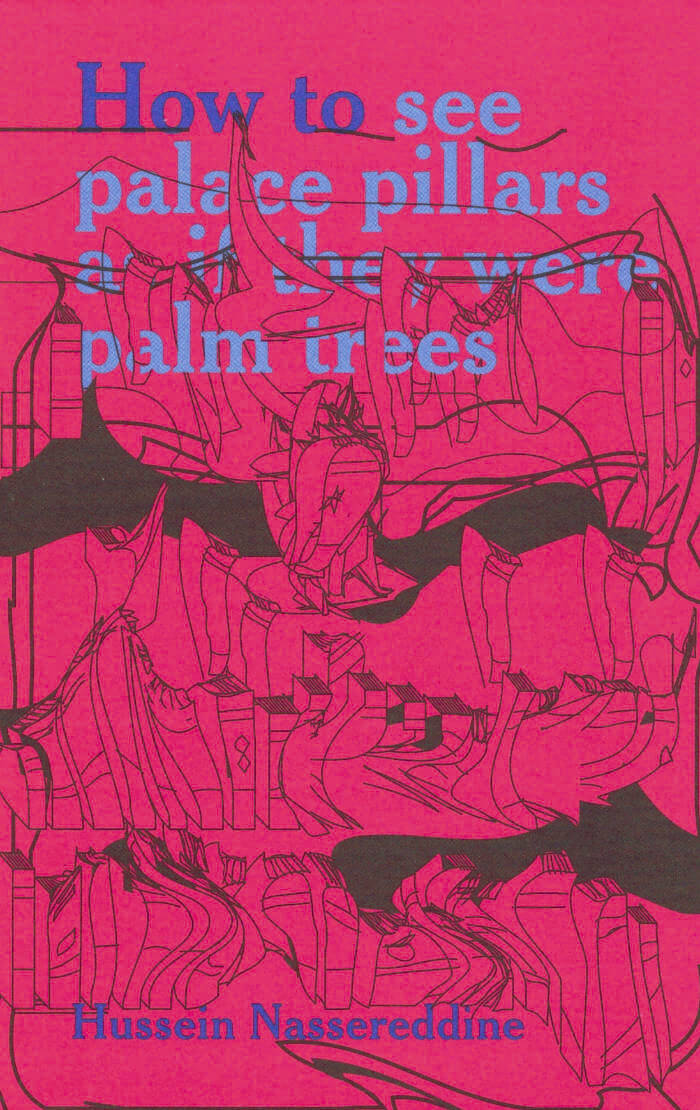
How to see palace pillars as if they were palm trees
For so it happens that when the poets speak, objects appear closer to their own shadows. The poet's mouth fills up with horses and marble, and his verses start to shine like rivers. These rivers then turn back to flow through the very palace he is depicting. The poet's own words begin to weigh down on him, as though he were holding up a palace with his palms. Then he travels, and the palace is obliterated. Countries and nations change, and naught remains but what the poets had seen. Of what the poets had seen, naught remains but its image in anthologies. And when the libraries have been flooded or burned to the ground, nothing but the commentaries on those anthologies are left, and all that one finds in these commentaries is that which was appropriated and wrought a thousand times over.
Hussein Nassereddine is a multidisciplinary artist. His work in installation, writing, video and performance originates from a practice around language that builds fragile monuments - some verbal, some sonic, some tactile - rooted in collective histories and resources of poetry, ruins, construction and image-making.
Translated from Arabic by Ben Koerber.

How to make female action heroes
M was exasperated by her friend's frivolous attitude toward the tragedy of losing a role. She was not trained to read the potential in R's wild imagination. Was it a commitment to realism, trained by the ideological morality of activism, that made her unresposive to the fantasy genre and vigilante characters? R's instinct was to court the unfamiliar, whereas M's training was to engage with criticality. Both these attributes could have interfaced in interesting and colourful ways, with sparks and currents, if and only if the social conditions of the time had been conducive to the arrival of a vigilante.
Madhusree Dutta is a filmmaker, curator and author based in Mumbai and Berlin. She has been the executive director of Majlis Culture, a centre for rights discourse and art initiatives in Mumbai, 1998-2016; and artistic director of Academy of the Arts of the World in Cologne, 2018-2021. Her areas of interest are documentary practices, urban cultures, migration movements, transient identities, and lived-in hybridity.

Alien Daughters Walk Into the Sun: An Almanac of Extreme Girlhood
The early writings of renowned poet and critical theorist Jackie Wang, drawn from her early zines, indie-lit crit, and prolific early 2000s blog.
Compiled as a field guide, travelogue, essay collection, and weather report, Alien Daughters Walk into the Sun traces Jackie Wang's trajectory from hard femme to Harvard, from dumpster dives and highway bike rides to dropping out of an MFA program, becoming a National Book Award finalist, and writing her trenchant book Carceral Capitalism. Alien Daughters charts the dream-seeking misadventures of an "odd girl" from Florida who emerged from punk houses and early Tumblr to become the powerful writer she is today. Anarchic and beautifully personal, Alien Daughters is a strange intellectual autobiography that demonstrates Wang's singular self-education: an early life lived where every day and every written word began like the Tarot's Fool, with a leap of faith.

Nice: Collected Poems
Collected for the first time, four landmark works of queer experimental poetry by reclusive cult poet David Melnick, known for his prowess with invented language and sound poetry.
David Melnick's Nice: Collected Poems spans twenty crucial years of gay life and experimentation with poetic form, bringing together four masterworks of American literature: Eclogs (1967-70), ten episodes in the urban afterlife of pastoral; PCOET (1972), written in an unknown tongue, verse for a world that's yet to be; Men in Aida (1983-85), Melnick's masterpiece, a giddy epic of queer community; and A Pin's Fee (1988), a backward glance and elegy, a cry of pain, howl of anger.
David Melnick was born in Illinois in 1938 and raised in Los Angeles, educated at the University of Chicago (where he studied with Hannah Arendt) and the University of California at Berkeley. Although he spent time in France, Greece, and Spain (whence his mother's ancestors emigrated in 1492), most of his adult life was centered in San Francisco. For an author's note he once wrote, "This poet's politics are left, his sexual orientation gay, his family Jewish.... He is short, fat, and resembles Modeste Moussorgsky in face and Gertrude Stein in body type and posture." A participant in the Free Speech movement, Melnick was a key member of G.A.W.K. (Gay Artists and Writers Kollective) and an early inspiration to the Language Poets. His masterpiece, Men in Aida, began in a reading group organized by Robert Duncan. Melnick passed away in 2022, a day before his 84th birthday.

New Bones Abolition: Captive Maternal Agency and the (After)Life of Erica Garner
New Bones Abolition addresses "those of us broken enough to grow new bones" in order to stabilize our political traditions that renew freedom struggles.
Reflecting on police violence, political movements, Black feminism, Erica Garner, Mumia Abu-Jamal, caretakers and compradors, Joy James analyzes the "Captive Maternal," which emerges from legacies of colonialism, chattel slavery and predatory policing, to explore the stages of resistance and communal rebellion that manifest through war resistance. She recognizes a long line of gendered and ungendered freedom fighters, who, within a racialized and economically-stratified democracy, transform from coerced or conflicted caretakers into builders of movements, who realize the necessity of maroon spaces, and ultimately the inevitability of becoming war resisters that mobilize against genocide and state violence.
New Bones Abolition weaves a narrative of a historically complex and engaged people seeking to quell state violence. James discusses the contributions of the mother Mamie Till-Mobley who held a 1955 open-casket funeral for her fourteen-year-old Emmett Till, murdered by white nationalists; the 1971 rebels at Attica prison; the resilience of political prisoners despite the surplus torture they endured; the emergence of Black feminists as political theorists; human rights advocates seeking abolition; and the radical intellectualism of Erica Garner, daughter of Eric Garner slain in 2014 by the NYPD. James positions the Captive Maternal within the evolution of contemporary abolition. Her meditation on, and theorizing of, Black radicals and revolutionaries works to honor Agape-driven communities and organizers that deter state/police predatory violence through love, caretaking, protest, movements, marronage, and war resistance.
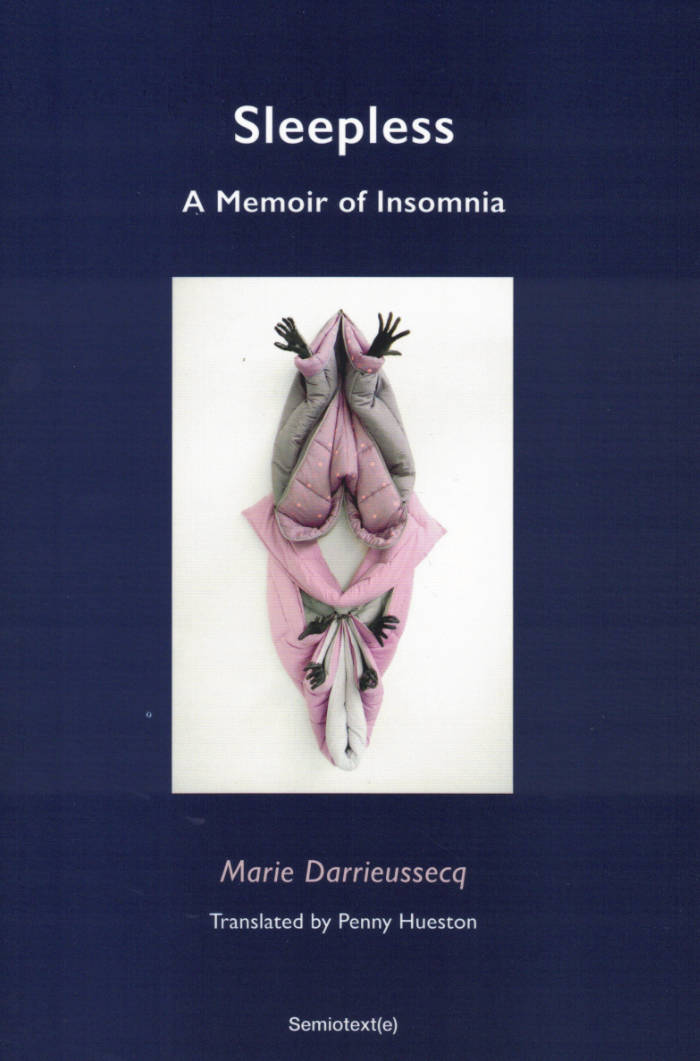
Sleepless: A Memoir of Insomnia
A restless inquiry into the cultural and psychic sources of insomnia by one of contemporary French literature's most elegant voices.
Plagued by insomnia for twenty years, Marie Darrieussecq turns her attention to the causes, implications, and consequences of sleeplessness: a nocturnal suffering that culminates at 4 a.m. and then defines the next day. “Insomniac mornings are dead mornings,” she observes. Prevented from falling asleep by her dread of exhaustion the next day, Darrieussecq turns to hypnosis, psychoanalysis, alcohol, pills, and meditation. Her entrapment within this spiraling anguish prompts her inspired, ingenious search across literature, geopolitical history, psychoanalysis, and her own experience to better understand where insomnia comes from and what it might mean. There are those, she writes, in Rwanda, whose vivid memories of genocide leave them awake and transfixed by complete horror; there is the insomnia of the unhoused, who have nowhere to put their heads down. The hyperconnection of urban professional life transforms her bedroom from a haven to a dormant electrified node.
Ranging between autobiography, clinical observation, and criticism, Sleepless is a graceful, inventive meditation by one of the most daring, inventive novelists writing today.

Firestar
«Avec Firestar, AD Rose tire une balle dans les jambes de celleux qui regardent leurs pieds» *
Une écriture dont le style évoque le rap, avec ses rimes, sa part de violence, de néologismes et d’égotrip, outil de lutte contre les injustices et l’ordre établi, celui de la langue comme celui de l’inceste. AD a 22 ans lorsqu’il quitte sa famille, écrit Firestar et nous accorde sa confiance pour le publier. Un travail testimonial rare sur les violences intra-familiales à la racine des systèmes de domination, un attentat poétique pour ne pas oublier.Lorsqu’en 2021 sa mémoire traumatique se réveille, AD Rose tente d'obtenir réparation auprès de ses parents, coupables de l'avoir incestué. Face au mur d’omerta auquel il se heurte, il trouve pouvoir dans l’écriture. Comme un réflexe de survie pour crier, sans demander la permission, libéré de la honte et des secrets. Un mouvement sans concession pour reprendre sa vie.
* Le texte est accompagné d’une préface de Victoria Xardel.
AD Rose est un poète français né en 1999. Il grandit dans le Tarn et le Tarn-et-Garonne, entre Vénès et Loze.
Victoria Xardel est une poète française née en 1987. Elle grandit en Alsace-Lorraine, entre Metz et Strasbourg.

18 Brum’Hair
Phœbe Hadjimarkos-Clarke, Martin Desinde
18 Brum’Hair est un recueil de poèmes écrits à quatre mains par Martin Desinde et Phœbe Hadjimarkos-Clarke au rythme du calendrier révolutionnaire. Si son titre fait référence—non sans un humour capillotracté—au coup d’État de Louis Bonaparte et au livre de Karl Marx traitant du dit-sujet, les auteur·ice·s écrivent ici en ping-pong sur notre temps présent et divaguent autour de sujets divers tels que l’état du monde, la vie urbaine, les drogues et l’alcool, la séduction, la sexualité, l’amour, le chagrin, l’amitié, la révolution... Ces 18 poèmes sont accompagnés de 12 allégories dessinées par Flore Chemin.
Un 18 brumaire littéraire, sans doute plus proche de la farce que de la tragédie.
Martin Desinde est auteur, éditeur et graphiste installé à Paris. Son travail fait dialoguer poésie et idéologie au travers de multiples formes: textes, objets éditoriaux, ready-mades, performances... Il fonde en 2017 la maison d'édition Dépense Défensive avec l’artiste Louis Somveille.
Phœbe Hadjimarkos-Clarke écrit des romans et des poésiesoù elle explore la vie organique et sentimentale au temps du capitalisme tardif. Elle vit dans de grandes villes et de petits villages.
Flore Chemin vit et travaille entre Paris et la Corrèze, sa pratique s’articule autour de la peinture, l’édition et l’installation. Elle y cultive une esthétique de l’à peu près qui répond à divers principes: faire d’abord / comprendre après, rester floue.s pour résister sous cape, inviter le monstre et les mauvaises herbes au cœur du jardin.
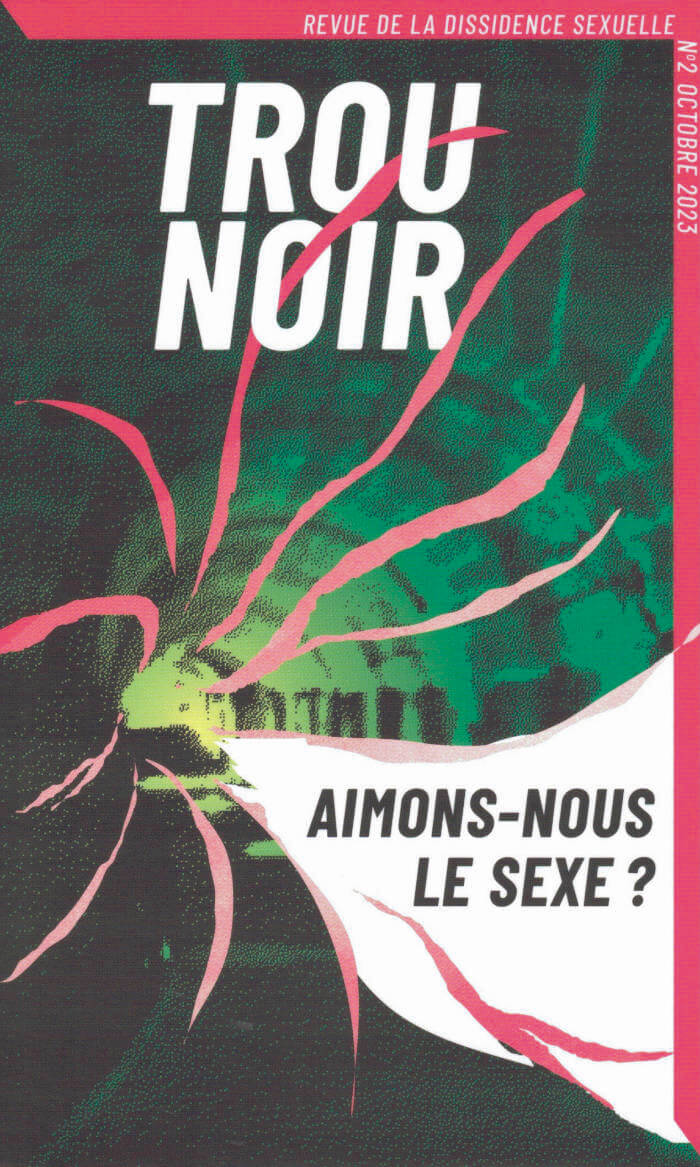
Trou noir, n°2 : Aimons-nous le sexe ?
Aimons-nous le sexe ? Ce numéro de Trou Noir cherche à explorer ce que le sexe et le politique auraient encore à fricoter ensemble, et à articuler nos paroles sans pour autant les faire se confondre. Bien sûr, répondre « oui » ou « non » à cette question ne relève pas de l’évidence et ne permettra pas de se situer sur une quelconque échelle de la dissidence sexuelle, mais y répondre quand même en allant puiser en soi-même, dans la littérature, dans la recherche, dans l’histoire, dans des expériences de groupe, dans toutes formes susceptibles de nous aider à penser le désir sexuel comme une résistance au pouvoir.
Sommaire
• Correspondance dans la galère de communiquer sur les insectes, le sexe et les faux problèmes – par L. Bigòrra & Brenda Walsh
• Ceci n’est pas une chatte – par Catalina Malabutch
• Fragments scatopolitiques – par Cy Lecerf Maulpoix
• Du sexe et des symbioses – par emma bigé
• Ça ressemble au sexe – par Mickaël Tempête
• Queer cruising – par Gorge Bataille + Saram
• Le caractère destructeur de la sexualité – par Quentin Dubois
• Se dire prosexe – par val flores